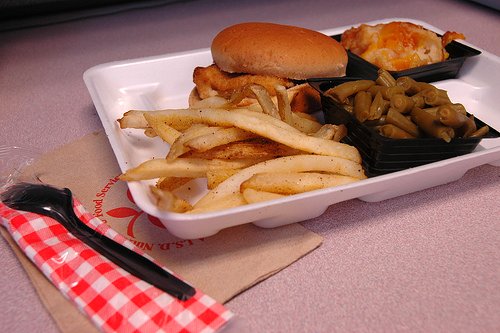 Blanche Lincoln, chair of the Senate Ag Committee. Tight purse strings for kids and conservation; loose ones for large-scale farmers. Remember when Obama rolled out his proposal for increasing the school-lunch budget, and lots of folks, including me, groaned that it wasn’t nearly enough?
Blanche Lincoln, chair of the Senate Ag Committee. Tight purse strings for kids and conservation; loose ones for large-scale farmers. Remember when Obama rolled out his proposal for increasing the school-lunch budget, and lots of folks, including me, groaned that it wasn’t nearly enough?
In his budget proposal earlier this year, Obama called for an additional $10 billion for school lunches over ten years, or $1 billion per year. Currently, we spend about $11 billion annually on school lunches — less than a month’s worth of military spending. At that level, school administrators typically have less than a dollar a day to spend on ingredients for each lunch they serve. To see what such a miserly outlay means for the nation’s public-school kids, see Ed Bruske’s great recent series of posts; or check in on the Fed Up blog, which features snapshots of the daily offerings at a school in Illinois. Or revisit the infamous “pink slime” scandal.
Obama’s proposed increase would boost the current daily per-lunch outlay by less than 20 cents — not enough to buy an extra apple a day for every kid.
Now Blanche Lincoln (D.-Ark), the agribiz-friendly chair of the Senate Ag committee, has come out with her draft of the School Lunch Reauthorization Act. She may be calling it the “Healthy, Hunger-Free Kids Act,” but what she proposes doing is slashing Obama’s proposed increase by more than half, to $4.5 billion over ten years.
If Obama can’t spare an extra two dimes per day per kid to spend on ingredients, Lincoln won’t even fork over a single extra dime. If Obama’s proposal wouldn’t even net an extra apple a day, Lincoln’s would have trouble procuring a single stick of gum — not that school kids need any more sugar.
And it gets worse. Because of Congress’ “pay-as-you-go” rules, Lincoln has to balance her modest increase with cuts in other agricultural spending. Naturally, she has chosen to target conservation, hunger, and even other school-lunch programs — leaving commodity payments, beloved of her state’s large-scale cotton farmers, intact. According to the ag news service DTN (quoted by Farm Policy blog):
Lincoln, D-Ark., said the bill would pay for the increased funding for the meals programs through a $2.2 billion shift in the Environmental Quality Incentives Program (EQIP), which would slow immediate spending but index it to inflation in the future, a $1 billion reduction in USDA purchases of commodities for school meal programs, and a $1.2 billion reduction in the food stamp nutrition education program.
Now, I’m not someone who believes we should willy-nilly slash commodity payments — not without a system in place to help farmers transition out of program crops like corn and soy. But if we have to treat food/ag-spending as a zero-sum game — any increase in one program must be offset by cuts in another — it would make much more sense to cut stuff like corn, soy, and cotton subsidies than to attack conservation and hunger programs.
One way to do so gracefully would be to lower the income cap on eligibility for crop subsidies. Between 1995 and 2006, the farm program paid out $140.2 billion in crop subsidies — an average of $12 billion per year, or roughly equal to the annual school-lunch budget.
That annual gusher of cash has benefitted large crop buyers (think meat giants like Tyson and grain traders like Cargill and input suppliers (e.g., seed giant Monsanto) much more than it has farmers. And the farmers who do benefit tend to be the very largest ones. Right now, people making as much as $500,000 annually are eligible to receive farm-program payments. That’s indefensible. To fund her tiny bump in school-lunch spending, Lincoln could at least lower that cap to a reasonable level. It makes sense to support working farmers, but it makes no sense to hand government cash to rich people who happen to own some farmland.
Another would be to put stricter limits on how much cash any one farm can receive.
But Lincoln has long battled against such eminently sensible measures — in part, perhaps, because her own family has benefitted from the subsidy system.
For the record, I think the “fiscal responsibility” zeal now sweeping through Congress is equal parts delusion and sham. For a vigorous debunking of the current fixation on deficits, see James K. Galbraith’s recent Nation essay. Real fiscal responsibility would mean ramping down military misadventures and making smart investments in future health, prosperity, and ecological sanity. Devoting real resources to school lunches is a perfect example. Doing otherwise is a grave mistake.



